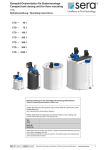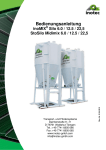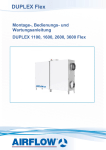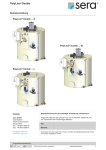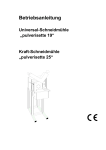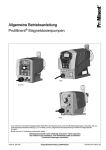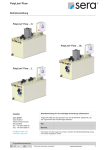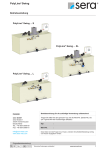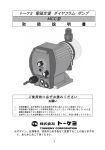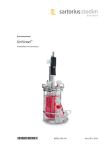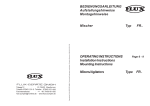Download intext:Betriebsanleitung filetype:pdf
Transcript
Elektrorührwerk Electric agitator MU-...E(G)1500... Betriebsanleitung / Operating instructions MU– 100 E 1500.2 MU– 200 E(G)1500.2 MU– 300 E(G)1500.2 MU– 500 E(G)1500.1 MU– 1000E(G)1500.1 Hersteller / Manufacturer: sera GmbH sera-Straße 1 34376 Immenhausen Deutschland / Germany Tel.: +49 5673 999-00 Fax: +49 5673 999-01 [email protected] www.sera-web.com Betriebsanleitung für die zukünftige Verwendung aufbewahren! Keep the operating manual for future use! Tragen Sie bitte hier den genauen Typ und die Werk-Nr. (Serien-Nr.) ein. (am Typenschild des Produktes ablesbar) Record the exact type and serial number here. (can be read off the type plate on the product) Typ Type : Werk-Nr. Serial No. : Diese Daten sind bei Fragen wichtig und müssen angegeben werden. These data are important in case of queries and must absolutely be stated. DE Originalbetriebsanleitung EN Translation of the original operating instructions TA 452 Rev. 4 de/en 03/2015 Technische Änderungen vorbehalten! / Subject to technical modifications! www.sera-web.com 1 Elektrorührwerk Electric agitator MU-...E(G)1500... Betriebsanleitung / Operating instructions 2 www.sera-web.com Technische Änderungen vorbehalten! / Subject to technical modifications! TA 452 Rev. 4 de/en 03/2015 Elektrorührwerk Electric agitator MU-...E(G)1500... Betriebsanleitung / Operating instructions Betriebsanleitung DE ab Seite 4 Operating Instructions EN from page 32 TA 452 Rev. 4 de/en 03/2015 Technische Änderungen vorbehalten! / Subject to technical modifications! www.sera-web.com 3 Elektrorührwerk MU-...E(G)1500... Betriebsanleitung Inhalt DE 1. Allgemein��������������������������������������������������������������������������������������������������������������������������������������������������� 6 1.1 Allgemeine Benutzerhinweise�������������������������������������������������������������������������������������������������������������� 6 1.2 Kennzeichnung von Hinweisen (in dieser Betriebsanleitung)�������������������������������������������������������������� 6 1.3 Kennzeichnung von Hinweisen (am Produkt)�������������������������������������������������������������������������������������� 7 1.4 Qualitätshinweise��������������������������������������������������������������������������������������������������������������������������������� 7 2. Sicherheitshinweise���������������������������������������������������������������������������������������������������������������������������������� 8 2.1 Personalqualifikation und Schulung����������������������������������������������������������������������������������������������������� 8 2.2 Gefahren bei Nichtbeachtung der Sicherheitshinweise������������������������������������������������������������������������ 8 2.3 Sicherheitsbewusstes Arbeiten������������������������������������������������������������������������������������������������������������ 8 2.4 Sicherheitshinweise für den Betreiber/Bediener���������������������������������������������������������������������������������� 8 2.5 Sicherheitshinweise für Wartungs-, Inspektions- und Montagearbeiten���������������������������������������������� 8 2.6 Eigenmächtiger Umbau������������������������������������������������������������������������������������������������������������������������ 9 2.7 Unzulässige Betriebsweisen���������������������������������������������������������������������������������������������������������������� 9 2.8 Bestimmungsgemäße Verwendung����������������������������������������������������������������������������������������������������� 9 2.9 Persönliche Schutzeinrichtungen bei Wartung und Instandsetzung�������������������������������������������������� 10 2.10 Betriebsstoffe����������������������������������������������������������������������������������������������������������������������������������� 10 2.11 Vorhersehbare Fehlanwendungen��������������������������������������������������������������������������������������������������� 11 2.11.1 Transport���������������������������������������������������������������������������������������������������������������������������������� 11 2.11.2 Zusammenbau und Installation������������������������������������������������������������������������������������������������ 11 2.11.3 Inbetriebnahme������������������������������������������������������������������������������������������������������������������������� 11 2.11.4 Betrieb�������������������������������������������������������������������������������������������������������������������������������������� 11 2.11.5 Wartung / Reparatur����������������������������������������������������������������������������������������������������������������� 12 2.11.6 Reinigung��������������������������������������������������������������������������������������������������������������������������������� 12 2.11.7 Zerlegung��������������������������������������������������������������������������������������������������������������������������������� 12 2.11.8 Entsorgung������������������������������������������������������������������������������������������������������������������������������� 12 2.11.9 Außerbetriebnahme������������������������������������������������������������������������������������������������������������������ 12 3. Transport und Lagerung������������������������������������������������������������������������������������������������������������������������� 13 3.1 Allgemein�������������������������������������������������������������������������������������������������������������������������������������������� 13 3.2 Transport�������������������������������������������������������������������������������������������������������������������������������������������� 13 3.3 Lagerung�������������������������������������������������������������������������������������������������������������������������������������������� 14 4. Produktbeschreibung����������������������������������������������������������������������������������������������������������������������������� 15 4.1 Typen�������������������������������������������������������������������������������������������������������������������������������������������������� 15 4.1.1 Typenschlüssel��������������������������������������������������������������������������������������������������������������������������� 15 4.1.2 Typenschild�������������������������������������������������������������������������������������������������������������������������������� 16 4.2 Werkstoffe������������������������������������������������������������������������������������������������������������������������������������������ 16 4.3 Viskosität, Fördermedium������������������������������������������������������������������������������������������������������������������� 16 4.4 Aufbau und Optionen�������������������������������������������������������������������������������������������������������������������������� 17 4.5 Funktionsbeschreibung���������������������������������������������������������������������������������������������������������������������� 18 4.5.1 Allgemein������������������������������������������������������������������������������������������������������������������������������������ 18 4.5.2 Antriebsmotor����������������������������������������������������������������������������������������������������������������������������� 18 4.6 Zubehör���������������������������������������������������������������������������������������������������������������������������������������������� 18 4.6.1 Traverse������������������������������������������������������������������������������������������������������������������������������������� 18 5. Technische Daten������������������������������������������������������������������������������������������������������������������������������������ 19 5.1 Technische Daten������������������������������������������������������������������������������������������������������������������������������� 19 5.2 Motordaten����������������������������������������������������������������������������������������������������������������������������������������� 19 5.3 Abmessungen������������������������������������������������������������������������������������������������������������������������������������� 20 6. Aufstellung / Installation������������������������������������������������������������������������������������������������������������������������� 21 7. Montage / Demontage����������������������������������������������������������������������������������������������������������������������������� 21 7.1 Montage��������������������������������������������������������������������������������������������������������������������������������������������� 22 7.2 Demontage����������������������������������������������������������������������������������������������������������������������������������������� 22 8. Elektrische Anschlüsse�������������������������������������������������������������������������������������������������������������������������� 23 8.1 Netzanschluss������������������������������������������������������������������������������������������������������������������������������������ 23 8.2 Drehrichtung��������������������������������������������������������������������������������������������������������������������������������������� 23 8.3 Klemmenkasten���������������������������������������������������������������������������������������������������������������������������������� 23 8.4 Motorschutz���������������������������������������������������������������������������������������������������������������������������������������� 23 4 www.sera-web.com Technische Änderungen vorbehalten! TA 452 Rev. 4 de 03/2015 Elektrorührwerk MU-...E(G)1500... Betriebsanleitung DE 9. Inbetriebnahme���������������������������������������������������������������������������������������������������������������������������������������� 24 9.1 Antriebsmotor������������������������������������������������������������������������������������������������������������������������������������� 24 9.2 Erstinbetriebnahme / Wiederinbetriebnahme������������������������������������������������������������������������������������� 24 10. Bedienung���������������������������������������������������������������������������������������������������������������������������������������������� 24 11. Wartung�������������������������������������������������������������������������������������������������������������������������������������������������� 25 11.1 Allgemein������������������������������������������������������������������������������������������������������������������������������������������ 25 11.2 Antriebsmotor����������������������������������������������������������������������������������������������������������������������������������� 25 12. Fehleranalyse und -Behebung������������������������������������������������������������������������������������������������������������� 26 13. Außerbetriebnahme������������������������������������������������������������������������������������������������������������������������������� 27 14. Entsorgung�������������������������������������������������������������������������������������������������������������������������������������������� 27 14.1 Abbau und Transport������������������������������������������������������������������������������������������������������������������������ 27 14.2 Komplett-Entsorgung������������������������������������������������������������������������������������������������������������������������ 27 15. Unbedenklichkeitsbescheinigung������������������������������������������������������������������������������������������������������� 28 TA 452 Rev. 4 de 03/2015 Technische Änderungen vorbehalten! www.sera-web.com 5 Elektrorührwerk MU-...E(G)1500... Betriebsanleitung 1. Allgemein 1.1 Allgemeine Benutzerhinweise Für das sera Elektrorührwerk sind grundsätzlich die am Aufstellungsort geltenden Vorschriften vor Inbetriebnahme und während des Betriebs zu beachten. Das sera Elektrorührwerk wird anschlussfertig geliefert. Vor der Montage und Inbetriebnahme sind unbedingt die hier aufgeführten Anweisungen und besonders die Sicherheitshinweise zu beachten. 1.2 Kennzeichnung von Hinweisen (in dieser Betriebsanleitung) Besondere Hinweise in dieser Betriebsanleitung sind mit Text und Gefahrsymbolen gekennzeichnet. Benennung des Hinweises Art der Gefahr WARNUNG! Sachschaden X X X X VORSICHT! ACHTUNG! X X X X X Bezeichnet eine unmittelbar drohende Gefahr. Wenn sie nicht gemieden wird, drohen Lebensgefahr oder schwerste Verletzungen. Bezeichnet eine möglicherweise gefährliche Situation. Wenn sie nicht gemieden wird, können Lebensgefahr oder schwere Verletzungen und Sachschäden die Folge sein. Bezeichnet eine möglicherweise gefährliche Situation. Wenn sie nicht gemieden wird, können leichte oder geringfügige Verletzungen oder Sachschäden die Folge sein. Bezeichnet eine möglicherweise gefährliche Situation. Wenn sie nicht gemieden wird, können Sachschäden die Folge sein. Bezeichnet Informationen, die zur Arbeitserleichterung beitragen und für einen störungsfreien Betrieb hilfreich sind. HINWEIS! 6 Verletzungsgefahr GEFAHR! (in der Betriebsanleitung) Lebensgefahr DE (Text und Symbol) Definition des Hinweises www.sera-web.com Technische Änderungen vorbehalten! TA 452 Rev. 4 de 03/2015 Elektrorührwerk MU-...E(G)1500... Betriebsanleitung 1.3 Kennzeichnung von Hinweisen (am Produkt) Direkt an das Elektrorührwerk angebrachte Hinweise, wie z. B. Drehrichtungspfeile müssen unbedingt beachtet und in vollständig lesbarem Zustand gehalten werden. 1.4 Qualitätshinweise Die Beachtung dieser Betriebsanleitung und insbesondere der Sicherheitshinweise hilft, ■■ Gefahren für Menschen, Maschinen und Umwelt zu vermeiden, ■■ Zuverlässigkeit und Lebensdauer des Elektrorührwerkes zu erhöhen und ■■ Reparaturkosten und Ausfallzeiten zu verringern. Das sera Qualitätsmanagement und Qualitätssicherungssystem ist zertifiziert nach ISO 9001:2008. Das sera Produkt entspricht den gültigen Sicherheitsanforderungen und Unfallverhütungsvorschriften. Diese Betriebsanleitung immer zugänglich am Einsatzort des Elektrorührwerkes aufbewahren! DE ACHTUNG! TA 452 Rev. 4 de 03/2015 Technische Änderungen vorbehalten! www.sera-web.com 7 Elektrorührwerk MU-...E(G)1500... Betriebsanleitung 2. Sicherheitshinweise 2.1 Personalqualifikation und Schulung Das Personal für Bedienung, Wartung, Inspektion und Montage muss die entsprechende Qualifikation für diese Arbeiten aufweisen. Verantwortungsbereich, Zuständigkeit und die Überwachung des Personals müssen durch den Betreiber genau geregelt sein. Verfügt das Personal nicht über die notwendigen Kenntnisse, so sind entsprechende Schulungen und Unterweisungen durch den Betreiber vorzunehmen. Dies kann, falls erforderlich, im Auftrag des Betreibers des Elektrorührwerks durch den Hersteller/Lieferanten erfolgen. Weiterhin ist durch den Betreiber sicherzustellen, dass der Inhalt der Betriebsanleitung durch das Personal verstanden wird. 2.2 Gefahren bei Nichtbeachtung der Sicherheitshinweise Die Nichtbeachtung der Sicherheitshinweise kann sowohl eine Gefährdung für Personen als auch für Umwelt und Elektrorührwerk zur Folge haben. Im einzelnen kann Nichtbeachtung beispielsweise folgende Gefährdung nach sich ziehen: ■■ Versagen wichtiger Funktionen des Elektrorührwerks. ■■ Versagen vorgeschriebener Methoden zur Wartung und Instandhaltung. ■■ Gefährdung von Personen durch elektrische, mechanische und chemische Einwirkungen. ■■ Gefährdung der Umwelt durch Leckage von gefährlichen Stoffen. DE 2.3 Sicherheitsbewusstes Arbeiten Die in dieser Betriebsanleitung aufgeführten Sicherheitshinweise, die bestehenden nationalen Vorschriften zur Unfallverhütung, die jeweiligen Anwenderland gültigen Sicherheitsbestimmungen für das Fördermedium sowie eventuelle interne Arbeits-, Betriebs- und Sicherheitsvorschriften des Betreibers sind zu beachten. 2.4 Sicherheitshinweise für den Betreiber/Bediener Im Störfall auftretende Leckagen gefährlicher Fördergüter und Betriebsstoffe müssen so abgeführt werden, dass keine Gefährdung für Personen und die Umwelt entstehen. Gesetzliche Bestimmungen sind einzuhalten. Gefährdungen durch elektrische Energie sind auszuschließen. 2.5 Sicherheitshinweise für Wartungs-, Inspektions- und Montagearbeiten Der Betreiber hat dafür zu sorgen, dass alle Wartungs-, Inspektions- und Montagearbeiten von autorisiertem und qualifiziertem Fachpersonal ausgeführt werden, das sich durch eingehendes Studium der Betriebsanleitung ausreichend informiert hat. 8 www.sera-web.com Technische Änderungen vorbehalten! TA 452 Rev. 4 de 03/2015 Elektrorührwerk MU-...E(G)1500... Betriebsanleitung 2.6 Eigenmächtiger Umbau Umbau oder Veränderungen des Elektrorührwerks sind nur nach Absprache mit dem Hersteller zulässig. Eigenmächtiger Umbau des Elektrorührwerks heben jeglichen Gewährleistungsanspruch gegen den Hersteller auf. VORSICHT! 2.7 Unzulässige Betriebsweisen Die Betriebssicherheit des gelieferten Produkts ist nur bei bestimmungsgemäßer Verwendung entsprechend Kapitel „Bestimmungsgemäße Verwendung“ gewährleistet. 2.8 Bestimmungsgemäße Verwendung Die sera Elektrorührwerke dienen zum Homogenisieren und Mischen des Mischgutes und sind ausschließlich für den in Produktbeschreibung und Abnahmeprüfbescheinigung angegebenen Verwendungszweck einzusetzen. Bei Änderungen des Verwendungszweckes muss die Eignung des Elektrorührwerks für die neuen Einsatzbedingungen mit sera geklärt werden! ■■ Eigenschaften des Mischgutes berücksichtigen (siehe hierzu Sicherheits- und Produktdatenblatt des verwendeten Mischgutes - das Sicherheitsdatenblatt ist vom Lieferanten / Betreiber des Mischgutes beizustellen). ■■ Die Werkstoffbeständigkeit des Rührwerkes gegen des Mischgutes ist vor der Inbetriebnahme sicherzustellen. ■■ Betriebsbedingungen am Aufstellungsort. ■■ Druck und Temperatur des Mischgutes. ■■ Spannungsversorgung. ■■ Aufstellungsort (Umweltbedingungen). DE Kriterien für den bestimmungsgemäßen Gebrauch des Elektrorührwerks: sera übernimmt keine Haftung, wenn diese Kriterien nicht oder nur unvollständig vom Besteller / Betreiber angegeben bzw. eingehalten werden. TA 452 Rev. 4 de 03/2015 Technische Änderungen vorbehalten! www.sera-web.com 9 Elektrorührwerk MU-...E(G)1500... Betriebsanleitung 2.9 Persönliche Schutzeinrichtungen bei Wartung und Instandsetzung Die Sicherheitsratschläge der Gefahrstoffverordnung (GefStoffV) der BRD (§ 14 Sicherheitsdatenblatt) bzw. die im jeweiligen Anwenderland gültigen Sicherheitsbestimmungen für das Medium müssen beachtet werden. Im Störfall ist auf folgende mögliche Emissionen zu achten: ■■ Austreten von Flüssigkeiten. ■■ Austreten von Dämpfen. Emissionen sind durch entsprechende Kontrollsysteme der Gesamtanlage zu überwachen. Schutzanzug, Schutzhandschuhe, sowie geeigneten Gesichts- und Atemschutz verwenden ! ACHTUNG! Persönliche Schutzausrüstungen müssen vom Betreiber des Elektrorührwerks zur Verfügung gestellt werden! DE HINWEIS! HINWEIS! 2.10 Betriebsstoffe Die sera Elektrorührwerke werden lebensdauergeschmiert geliefert. 10 www.sera-web.com Technische Änderungen vorbehalten! TA 452 Rev. 4 de 03/2015 Elektrorührwerk MU-...E(G)1500... Betriebsanleitung 2.11 Vorhersehbare Fehlanwendungen Die nachfolgenden Fehlanwendungen sind den Lebensphasen der Maschinen zugeordnet. Fehlanwendungen können zu einer Gefährdung des Bedienpersonales führen! GEFAHR! 2.11.1 Transport ■■ ■■ ■■ Kippverhalten bei Transport sowie Auf- und Abladen nicht beachtet. Beim Anheben das Gewicht unterschätzt. Tragen von keiner bzw. nicht ausreichender Schutzausrüstung. ■■ ■■ ■■ ■■ ■■ Nicht abgesichertes Netz (keine/zu große Sicherung, nicht normgerechtes Netz). Aufstellung des Elektrorührwerks an einem ungeeignetem Ort (außen, direkte Sonneinstrahlung, Ex-Bereich usw.). Keine Ausreichende Fixierung während der Montage / Kippen der Maschine. Elektrischer Anschluss nicht vorschriftsmäßig (ohne Schutzleiter, Netz nicht abgesichert, falsche Drehrichtung usw.). Tragen von keiner bzw. nicht ausreichender Schutzausrüstung. 2.11.3 Inbetriebnahme ■■ ■■ ■■ ■■ ■■ Nichtbeachten der Auslegungsdaten/Betriebsbedingungen (Medium, Temperaturen usw.). Nichtbeachten der elektrischen Kenndaten (Motoren, Sensoren). Abdecken von Lüftungsöffnungen (Motor). Inbetriebnahme mit beschädigter Anlage. Tragen von keiner bzw. nicht ausreichender Schutzausrüstung. 2.11.4 Betrieb ■■ ■■ ■■ ■■ ■■ ■■ ■■ TA 452 Nicht ausreichende Befestigung des Elektrorührwerks. Störmeldung ignorieren ► Prozessfehler. Unzureichende Beleuchtung am Arbeitsplatz. Überbrücken der externen Sicherung - Keine Abschaltung im Fehlerfall. Eigenmächtiger Umbau des Elektrorührwerks (interne Sicherung, selbst angebaute Halterungen …). Im kritischen Drehzahlbereich betrieben. Tragen von keiner bzw. nicht ausreichender Schutzausrüstung. Rev. 4 de 03/2015 Technische Änderungen vorbehalten! www.sera-web.com 11 DE 2.11.2 Zusammenbau und Installation Elektrorührwerk MU-...E(G)1500... Betriebsanleitung 2.11.5 Wartung / Reparatur ■■ ■■ ■■ ■■ ■■ ■■ ■■ ■■ ■■ ■■ ■■ ■■ ■■ Missachten der Wartungsintervalle gem. Betriebsanleitung. Unsachgemäßes Durchführen der Wartung. Keine ausreichende Spülung vor Wartungsarbeiten. Weiterverwendung von Kabeln mit beschädigter Isolation. Kein Stillsetzen/ kein Schutz vor Wiedereinschalten vor Wartungsarbeiten. Durchführung von Reparaturen durch ungeschultes Personal. Ungeeignete unfachliche grobe Reparaturmethoden („Hammerreparatur“). Nicht geeignete oder keine Schutzkleidung. Schlecht belüfteter Raum. Wiederanfahren ohne ausreichende Befestigung. Beschädigung / nicht Einbau der Dichtung ► Medium/Gas tritt aus. Unerwarteter Wiederanfahren während der Wartung am Rührorgan. Tragen von keiner bzw. nicht ausreichender Schutzausrüstung. 2.11.6 Reinigung ■■ ■■ ■■ ■■ ■■ DE ■■ Tragen von keiner bzw. nicht ausreichender Schutzausrüstung. Falsches Spül-/Reinigungsmittel (Reaktion mit dem Medium). Verwendung von nicht geeigneten Putzutensilien. Ungeschultes Personal. Schlecht belüfteter Raum. Betätigung von Steuerelementen. 2.11.7 Zerlegung ■■ ■■ ■■ ■■ Verbleib von Mischmedium am Elektrorührwerk. Verwendung falscher Demontagewerkzeuge. Falsche oder keine Schutzkleidung. Schlecht belüfteter Raum. 2.11.8 Entsorgung ■■ ■■ Nicht fachgerechtes Entsorgen von Fördermedium und Werkstoffen. Keine Kennzeichnung von Gefahrstoffen. 2.11.9 Außerbetriebnahme ■■ ■■ ■■ 12 Abklemmen der elektrischen Anschlüsse in falscher Reihenfolge (Schutzleiter zuerst). Spannungsfreiheit nicht sichergestellt ► Gefahr durch Elektrizität. Schlecht belüfteter Raum. www.sera-web.com Technische Änderungen vorbehalten! TA 452 Rev. 4 de 03/2015 Elektrorührwerk MU-...E(G)1500... Betriebsanleitung 3. Transport und Lagerung 3.1 Allgemein sera Produkte werden vor Auslieferung auf einwandfreie Beschaffenheit und Funktion geprüft. Die Verpackung erfolgt entsprechend den Transportbedingungen. Der Transport erfolgt liegend. Nach Erhalt muss das Produkt unverzüglich auf Transportschäden kontrolliert werden. Sollten dabei Beschädigungen festgestellt werden, sind diese unverzüglich dem verantwortlichen Spediteur sowie dem Lieferanten mitzuteilen. Das Elektrorührwerk darf nur mit geeigneten Transportmitteln bzw. Hebezeugen transportiert werden. Dabei das Gewicht des Elektrorührwerks und die Tragfähigkeit des Transportmittels beachten. Verpackungsmaterialien sachgerecht entsorgen ! HINWEIS! DE 3.2 Transport Unfallverhütungsmaßnahmen beim Transport und Rangieren einhalten! WARNUNG! GEFAHR! Elektrische Versorgung abschalten und gegen Wiedereinschalten sichern! Bei Kontakt mit spannungsführenden Bauteilen besteht Lebensgefahr. Eingeschaltete elektrische Bauteile können unkontrollierte Bewegungen ausführen und zu schwersten Verletzungen führen. ■■ Elektrorührwerk nicht an der Welle tragen. ■■ Elektrorührwerk am Motorflansch/Motor tragen. ■■ Elektrorührwerk senkrecht tragen. ■■ Welle nicht auf Biegung belasten. TA 452 Rev. 4 de 03/2015 Technische Änderungen vorbehalten! www.sera-web.com 13 Elektrorührwerk MU-...E(G)1500... Betriebsanleitung 3.3 Lagerung Eine unbeschädigte Verpackung gewährleistet Schutz während der anschließenden Lagerzeit und ist erst dann zu öffnen, wenn das Elektrorührwerk installiert wird. Eine sachgemäße Lagerung erhöht die Lebensdauer des Elektrorührwerks. Sachgemäße Lagerung bedeutet das Fernhalten von negativen Einflüssen, wie Wärme, Feuchtigkeit, Staub, Chemikalien usw. . Folgende Lagervorschriften sind einzuhalten: ■■ Lagerort: kühl, trocken, staubfrei, keine direkte Sonneneinstrahlung und mäßig belüftet. ■■ Lagerungstemperaturen zwischen +2°C und + 45°C. ■■ Relative Luftfeuchtigkeit nicht über 50%. ■■ Die maximale Lagerzeit in der Standardausführung beträgt 12 Monate. Bei Überschreiten dieser Werte sind Produkte aus metallischen Werkstoffen luftdicht in Folie einzuschweißen und mit geeignetem Bindemittel gegen Schwitzwasser zu schützen. DE Lösungsmittel, Kraftstoffe, Schmierstoffe, Chemikalien, Säuren, Desinfektionsmittel u.ä. nicht im Lagerraum aufbewahren. 14 www.sera-web.com Technische Änderungen vorbehalten! TA 452 Rev. 4 de 03/2015 Elektrorührwerk MU-...E(G)1500... Betriebsanleitung 4. Produktbeschreibung 4.1 Typen 4.1.1 Typenschlüssel Bezeichnung MU Mixing Unit Behältervolumen zugeordnetes Behältervolumen (Standardbehälter DTR) Ausführung (Kombinationen möglich) M Handmischer E Elektrorührwerk G Gasdicht Synchrondrehzahl EB Electronic board ohne keine Steuerelektronik DE Steuerelektronik Revisionsindex 1 MU - Beispiel: 2 3 4 5 500 E 1500 EB MU-1000EG1500.1 . 1 (Beispiel) Elektrorührwerk, gasdichte Ausführung für Behälter Typ DTR-1000.1, Synchrondrehzahl n=1500min-1 In der unten stehenden Tabelle sind die Typen das Elektrorührwerk aufgeführt. Die Kombination der Optionen ist miteinander möglich. Typenschlüssel Typ E Standard (Flansch: PE Rührwelle: 1.4571 1.4571 (Flansch: 1.4571 Rührwelle: 1.4571) G PE-Ummantelt (Flansch: PE Rührwelle: 1.4571/PE-umm.) MU-100E1500... gasdicht ---* MU-200E1500... MU-300E1500... MU-500E1500... MU-1000E1500... * MU-100EG1500... (gasdichte Ausführung) gibt es nur in Verbindung mit gasdichten CTD. TA 452 Rev. 4 de 03/2015 Technische Änderungen vorbehalten! www.sera-web.com 15 Elektrorührwerk MU-...E(G)1500... Betriebsanleitung 4.1.2 Typenschild Jedes sera Elektrorührwerk wird werksseitig mit einem Typenschild versehen. Das Typenschild erhält eine Typenbezeichnung des jeweiligen Elektrorührwerks und eine Werknummer. 4.2 Werkstoffe DE Die verwendeten Werkstoffe sind in der Produktbeschreibung im Anhang aufgeführt. Die Eignung der Werkstoffe für das Medium ist zu prüfen. 4.3 Viskosität, Fördermedium Das Elektrorührwerk ist für Flüssigkeiten mit Viskositäten 16 www.sera-web.com 200mPas geeignet und der max. Dichte von 1,2kg/dm3. Technische Änderungen vorbehalten! TA 452 Rev. 4 de 03/2015 Elektrorührwerk MU-...E(G)1500... Betriebsanleitung 4.4 Aufbau und Optionen Standard Ausführung PE-ummantelt / gasdicht 90 80 10 120 20 40 130 50 110 DE 100 70 30 60 Nr. Bezeichnung 10 Antrieb 20 Schutzflansch 30 Rührwelle 40 Unterlegscheibe 50 Zylinderschraube 60 Rührorgan 70 Radialdichtring 80 Pfeil 90 Typenschild 100 Verschlussstopfen 110 PE-Ummantelung 120 O-Ring 130 Laufbuchse TA 452 Rev. 4 de 03/2015 Standard (Flansch: PE Rührwelle: 1.4571 1.4571 (Flansch: 1.4571 Rührwelle: 1.4571) Technische Änderungen vorbehalten! PE-Ummantelt (Flansch: PE Rührwelle: 1.4571/PE-umm.) www.sera-web.com gasdicht 17 Elektrorührwerk MU-...E(G)1500... Betriebsanleitung 4.5 Funktionsbeschreibung 4.5.1 Allgemein Das Elektrorührwerk dient zum Homogenisieren und Mischen des Mischgutes. Die Rührwelle wird im Uhrzeigersinn senkrecht betrieben, um einerseits das Lösen des Rührorgans zu vermeiden, andererseits die axiale Mischrichtung zum Behälter zu richten. Das Rührwerk muss senkrecht betrieben werden, um so die Exzentritätsverlagerung zu vermeiden. Die Elektrorührwerke sind keine vollständige Maschinen. 4.5.2 Antriebsmotor Der Antrieb erfolgt mittels eines Drehstrommotors. (Informationen zum Anschluss des Antriebsmotors siehe Kapitel 8 / Motordaten siehe Kapitel 5.2) 4.6 Zubehör 4.6.1 Traverse DE Die Traverse (Gesamtlänge 1200mm) für die MU-200/300/500/1000E1500.1 kann auf offenen Behältern mit einem Außendurchmesser von min. 600mm bis max.1150mm (Befestigungsösen vorsehen) und IBC-Behältern (bis 1000L) mit Stahlrohrrahmen aufgesetzt und mit den Verschlussspannern verspannt werden. Auf, in der Schiene freibewegbaren, Flügelmuttern wird das Elektrorührwerk aufgesetzt und mit den M8-Sechskantschrauben fixiert, in die gewünschte Position geschoben und festverschraubt (siehe Bespiel unten). ACHTUNG! Flügelmutter Bei runden Behältern wegen der Trombenbildung auf die exzentrische Position des Elektrorührwerks achten (Exzentrität= 0,25 bis 0,33 x Behälterdurchmesser). Sechskantschrauben Verschlussspanner Traverse Elektrorührwerk Schiene IBC-Behälter 18 www.sera-web.com Technische Änderungen vorbehalten! TA 452 Rev. 4 de 03/2015 Elektrorührwerk MU-...E(G)1500... Betriebsanleitung 5. Technische Daten 5.1 Technische Daten Baugröße Antriebsmotor Typ für Behälter Gewicht BG Liter Typ kg MU-100E1500.2 71 100 DTR-100.2 8,4 MU-200E(G)1500.2 71 200 DTR-100.2 DTR-200.2 8,9 MU-300E(G)1500.2 71 300 DTR-300.2 9,7 MU-500E(G)1500.1 71 500 DTR-500.1 8,0 MU-1000E(G)1500.1 80 1000 DTR-1000.1 19,4 5.2 Motordaten Leistung Frequenz Spannung Nennstrom BG kW Hz V A 50Hz 60Hz 71 0,37 0,43 80 0,75 0,75 50Hz 50/60 1) 2) 230 - 400 60Hz 460 Isolations- Schutzart klasse 50Hz 60Hz 1,84 1) 1,06 2) 1,03 2) 3,15 1) 1,81 2) 1,51 2) F Drehzahl IP min-1 55 1500 DE Baugröße ∆ Dreieckschaltung Y Sternschaltung TA 452 Rev. 4 de 03/2015 Technische Änderungen vorbehalten! www.sera-web.com 19 Elektrorührwerk MU-...E(G)1500... Betriebsanleitung 5.3 Abmessungen B X K ØC ØM ØE DE L ØA ØD X Typ A B C D E K L M Standard 1.4571 PE-umm. mm 20 MU-100E... 120 108 7 100 100 248 564 551 22 MU-200E... 160 108 8,5 100 130 220 572 559 22 MU-300E... 160 108 8,5 100 130 220 822 822 22 MU-500E... 160 108 8,5 125 130 220 974 967 22 MU-1000E... 200 123 11 150 165 243 1069 1064 24 www.sera-web.com Technische Änderungen vorbehalten! TA 452 Rev. 4 de 03/2015 Elektrorührwerk MU-...E(G)1500... Betriebsanleitung 6. Aufstellung / Installation ■■ Das Elektrorührwerk ist nur für die Aufstellung in trockenen Räumen bei nicht aggressiver Atmosphäre und Temperaturen zwischen +2°C und +40°C sowie einer Luftfeuchtigkeit bis ca. 90% zugelassen. ■■ Keine direkte Sonneneinstrahlung. ■■ Abmessungen der Befestigungsbohrungen des Schutzflansches siehe Kapitel „Abmessungen“. ■■ Die Befestigungsschrauben auf festen Sitz prüfen und ggf. nachziehen (Anzugsdrehmomente der Befestigungsschrauben siehe Kapitel „Montage / Demontage“). ■■ Elektrorührwerk möglichst in bedienfreundlicher Höhe aufstellen. ■■ Maximale Aufstellungshöhe von 2000m (Leistungsreduzierung ab 1000m über NN). 7. Montage / Demontage Beginn der Arbeiten elektrische Versorgung abschalten und gegen Wiedereinschalten sichern! GEFAHR! Bei Kontakt mit spannungsführenden Bauteilen besteht Lebensgefahr. Eingeschaltete elektrische Bauteile können unkontrollierte Bewegungen ausführen und zu schwersten Verletzungen führen! DE ■■ Vor ■■ Vor Beginn der Arbeiten für ausreichende Montagefreiheit sorgen. ■■ Mit offenen, scharfkantigen Bauteilen vorsichtig umgehen. ■■ Auf Ordnung und Sauberkeit am Arbeitsplatz achten! Lose aufeinander- oder umherliegende Bauteile und Werkzeuge sind Unfallquellen. ■■ Bauteile sichern, damit sie nicht herabfallen oder umstürzen. Unsachgemäße Installation und Erstinbetriebnahme kann zu schweren Personenoder Sachschäden führen! VORSICHT! Eine Montage/Demontage des Elektrorührwerks darf nur bei leerem Behälter erfolgen. WARNUNG! Bei runden Behältern wegen der Trombenbildung auf die exzentrische Position des Elektrorührwerks achten (Exzentrität= 0,25 bis 0,33 x Behälterdurchmesser). ACHTUNG! TA 452 Rev. 4 de 03/2015 Technische Änderungen vorbehalten! www.sera-web.com 21 Elektrorührwerk MU-...E(G)1500... Betriebsanleitung 7.1 Montage ■■ Das Elektrorührwerk senkrecht in den Behälter einbauen. ■■ Das Elektrorührwerk darf nur in einem leeren Behälter montiert werden. ■■ Die für den Behälter festgelegte Position des Elektrorührwerks wird mit der Bohrschablone (siehe letzte Seite) gekennzeichnet und nach Geometrieangaben gebohrt. Die Späne aus dem Behälter aufsaugen. ■■ Bei PE-ummantelten Ausführung die Rührorganaufnahme mit PTFE-Band 8 bis10 mal im Uhrzeigersinn aufwickeln. ■■ Für die Montage des Elektrorührwerks werden 2 Personen benötigt. Das Elektrorührwerk wird am Flansch durch eine Person festgehalten und die Welle ohne Rührorgan durch die mittlere Bohrung durchgesteckt. ■■ Das Wellenende wird seitlich zur Behälteröffnung gekippt und durch die zweite Person das Rührorgan auf die Welle aufgeschraubt. DE ACHTUNG! Elektrorührwerk nicht im Behälter hängen lassen! / Die Welle nicht auf Biegung belasten! ■■ Das Elektrorührwerk wird mit dem Schraubenset am Behälter befestigt. Vorgeschriebene Schrauben-Anzugsdrehmomente einhalten: Schrauben Anzugsdrehmoment Nm M6 3,5 M8 4,0 M10 6,0 7.2 Demontage 22 ■■ Sicherheitsdatenblätter und Warnhinweise des gerührten Mediums beachten. ■■ Im Betrieb kann die Rührwelle am Flansch heiß werden. Nach Betrieb abkühlen lassen. ■■ Die Schraubenverbindung mit dem Behälter lösen. ■■ Für die Demontage des Elektrorührwerks werden 2 Personen benötigt. ■■ Das Elektrorührwerk wird am Flansch (Motorgehäuse) durch eine Person festgehalten. Das Wellenende wird seitlich zur Behälteröffnung gekippt und durch die zweite Person das Rührorgan von der Welle abgeschraubt. ■■ Das Elektrorührwerk wird aus dem Behälter entnommen. www.sera-web.com Technische Änderungen vorbehalten! TA 452 Rev. 4 de 03/2015 Elektrorührwerk MU-...E(G)1500... Betriebsanleitung 8. Elektrische Anschlüsse Der Antrieb des Elektrorührwerks erfolgt mittels eines Drehmotors. 8.1 Netzanschluss Die Anschlussart des Motors ist abhängig von der Spannungsangabe auf dem Typenschild und der angelegten Netzspannung. W2 Beispiel: Typenschildangabe: 230/400V Vorhandenes Drehstromnetz: 400V U1 Richtiger Motoranschluss: Sternschaltung (Y) U2 V2 W2 L1 V1 L2 W1 U1 L3 L1 ∆ Dreieckschaltung U2 V2 V1 L2 W1 L3 Y Sternschaltung 8.2 Drehrichtung Drehrichtung DE Die Drehrichtung des Antriebsmotors ist im Uhrzeigersinn und durch einen Pfeil auf der Motorhaube gekennzeichnet. VORSICHT! Beim Anschluss der Stromversorgung im Klemmkasten ist die Drehrichtung des Antriebs vor der Berührung mit dem Medium zu prüfen. Durch die falsche Drehrichtung wird das Medium nicht optimal gemischt und das Rührorgan kann sich dadurch lösen! 8.3 Klemmenkasten Vor dem Schließen des Klemmenkastens prüfen: ■■ fester Sitz aller Klemmenanschlüsse. ■■ Innenseite sauber und frei von Fremdkörpern. ■■ Unbenutzte Kabeleinführungen verschlossen und Verschlussschrauben fest angezogen. ■■ Dichtung im Klemmenkastendeckel sauber eingelegt; auf ordnungsgemäße Beschaffenheit aller Dichtflächen zur Gewährleistung der Schutzart achten. 8.4 Motorschutz Zum Schutz des Motors vor Überlastung entsprechende Motorschutzeinrichtungen vorsehen (z. B. Motorschutzschalter mit thermischem Überstromauslöser). Schutzleiter gemäß VDE 0100 unbedingt an der markierten Erdungsschraube anschließen. Sicherungen sind kein Motorschutz! VORSICHT! TA 452 Rev. 4 de 03/2015 Technische Änderungen vorbehalten! www.sera-web.com 23 Elektrorührwerk MU-...E(G)1500... Betriebsanleitung 9. Inbetriebnahme 9.1 Antriebsmotor Voraussetzungen: Netzverhältnisse (Spannung und Frequenz) mit den Angaben auf dem Typenschild des Motors vergleichen. Zulässige Spannungstoleranz (DIN VDE 0530) für Bemessungsspannung für Bemessungsspannungsbereich + 10% +/- 5% Die Anschlussleitung muss entsprechend den elektrischen Nenndaten des Motors dimensioniert sein. Zugentlastung der Anschlusskabel vorsehen. Angegebene Motor-Nennleistung gilt für max. 40°C Umgebungstemperatur und Aufstellungshöhen unter 1000m über NN. Werden diese Werte überschritten, verringert sich die Motorleistung (siehe VDE 0530). Eignung für Klimagruppe „moderate“ nach IEC 721-2-1. Der Betrieb des Elektrorührwerks führt zur Erwärmung des Antriebsmotors. Motor während des Betriebes nicht berühren! DE HINWEIS! 9.2 Erstinbetriebnahme / Wiederinbetriebnahme Kontrollen vor jeder Inbetriebnahme ■■ Prüfen, ob die Befestigungsschrauben des Flansches mit dem angegebenen Drehmoment angezogen sind, ggf. nachziehen. ■■ Prüfen, ob alle elektrischen Anschlüsse korrekt sind. ■■ Drehfreiheit des Rührorgans prüfen. 10. Bedienung Sobald der Antriebsmotor mit Spannung versorgt wird, fängt das Elektrorührwerk an zu arbeiten. HINWEIS! Das Elektrorührwerk verfügt über keinen I/O-Schalter. Vorrichtungen für das Ein- und Ausschalten des Elektrorührwerks müssen vom Betreiber installiert werden. 24 www.sera-web.com Technische Änderungen vorbehalten! TA 452 Rev. 4 de 03/2015 Elektrorührwerk MU-...E(G)1500... Betriebsanleitung 11. Wartung 11.1 Allgemein Eine Spülung der medienberührten Teile soll erfolgen: ■■ nach Mediumwechsel oder ■■ mindestens 1-2 Wochen (medienabhängig). Zum Anhaften neigende Medien können zu einer Unwucht der Rührwerkswelle führen, ggf. sind die Spülintervalle entsprechend anzupassen. ACHTUNG! GEFAHR! Exotherme Reaktionen müssen unter allen Umständen vermieden werden! Das Elektrorührwerk von der Spannungsversorgung trennen und gegen plötzlichen Anlauf durch geeignete Maßnahmen sichern. Hierzu unbedingt Elektro-Fachpersonal kontaktieren. DE GEFAHR! Die medienberührten Teile des Elektrorührwerks müssen mit Wasser oder geeignetem Medium gespült werden. Hierbei die Verträglichkeit des Spülmediums mit der Chemikalie gem. dem Sicherheitsdatenblatt berücksichtigen. Die Welle des Elektrorührwerks kann im Bereich des Flansches heiß sein. Vor Demontage abkühlen lassen! VORSICHT! Folgende Prüfungen sollten in regelmäßigen Abständen durchgeführt werden: ■■ Unversehrtheit der elektrischen Anschlüsse, ■■ fester Sitz der Flansch-Befestigungsschrauben (mindestens 1 mal jährlich auf festen Sitz prüfen). 11.2 Antriebsmotor Der Elektromotor muss immer sauber gehalten werden, sodass weder Staub, Schmutz, Öl oder sonstige Verunreinigungen den einwandfreien Betrieb stören können. Es wird außerdem empfohlen zu kontrollieren, ■■ ob der Motor ohne starke Schwingungen arbeitet bzw. ■■ dass Ansaug- und Ausblasöffnungen für die Kühlluftzufuhr nicht zugestellt oder verengt sind (unnötig hohe Wärmebildung in den Wicklungen). Die eingesetzten Kugellager im Motor sind lebensdauergeschmiert. TA 452 Rev. 4 de 03/2015 Technische Änderungen vorbehalten! www.sera-web.com 25 Elektrorührwerk MU-...E(G)1500... Betriebsanleitung 12. Fehleranalyse und -Behebung sera - Produkte sind ausgereifte, technische Erzeugnisse, die erst nach umfassender Prüfung unser Werk verlassen. Sollten dennoch Störungen auftreten, lassen sie sich schnell erkennen und mit den Hinweisen in der Tabelle beheben. Zu hohe Spannung Anschlussspannung prüfen █ █ █ Elektrische Daten des Antriebsmotors stimmen nicht mit dem Netz überein Bestelldaten prüfen. Elektroinstallation prüfen. Motor auf vorhandene Netzverhältnisse abstimmen █ █ █ Zu hohe Mediumviskosität Viskosität des Mediums prüfen und mit den Auslegungsdaten vergleichen ggf. die Viskosität herabsetzen odas Elektrorührwerk mit einem stärkeren Antriebsmotor einsetzen █ █ █ Temperatur zu niedrig Fließfähigkeit des Mediums prüfen █ █ █ Defekte Wicklung im Antriebsmotor Elektrorührwerk zur Reparatur senden █ █ Falscher Rührorgan (zu groß) Bestelldaten überprüfen. Für das Elektrorührwerk geeigneten Rührorgan montieren █ Motorklemmenkasten falsch verkabelt Die Schaltung im Klemmenkasten überprüfen █ Falsche Drehrichtung des Antriebsmotors Die Schaltung im Klemmenkasten überprüfen Montierte Position des Elektrorührwerks liegt in der Behältermitte Stromstörer in den Behälter einbauen oder das Elektrorührwerk exzentrisch montieren █ Transportschaden Elektrorührwerk zur Reparatur senden █ Betrieb mit einem Frequenzumrichter Kritische Drehzahlen vermeiden Lagerschaden Elektrorührwerk zur Reparatur senden █ Trombenbildung im Gemisch █ Starke Schwingungen der Welle Motorstromschutzschalter ausgelöst █ Rührorgan hat sich gelöst Antrieb ist überlastet Laute Laufgeräusche im Antriebsmotor Behebung der Störung █ █ █ █ 26 mögliche Ursache Antriebsmotor läuft nicht an DE Art der Störung www.sera-web.com Technische Änderungen vorbehalten! TA 452 Rev. 4 de 03/2015 Elektrorührwerk MU-...E(G)1500... Betriebsanleitung 13. Außerbetriebnahme ■■ Elektrorührwerk ■■ Die von der Spannungsversorgung trennen. medienberührte Teile des Elektrorührwerks mit geeignetem Medium spülen. 14. Entsorgung ■■ Elektrorührwerk außer Betrieb nehmen. Siehe Außerbetriebnahme. 14.1 Abbau und Transport ■■ Elektrorührwerk außer Betrieb nehmen. Siehe Außerbetriebnahme. ■■ Gründlich reinigen, neutralisieren und dekontaminieren. ■■ Gerät entsprechend verpacken und versenden. DE Für Sendungen an den Hersteller ist eine Unbedenklichkeitsbescheinigung auszufüllen (siehe Kapitel „Unbedenklichkeitsbescheinigung“). HINWEIS! 14.2 Komplett-Entsorgung ■■ Alle Flüssigkeitsreste durch Spülen entfernen. ■■ Alle Materialien sortenrein demontieren und einer geeigneten Verwertungsstelle zuführen! Für Schäden durch Flüssigkeitsreste haftet der Absender! WARNUNG! TA 452 Rev. 4 de 03/2015 Technische Änderungen vorbehalten! www.sera-web.com 27 Elektrorührwerk MU-...E(G)1500... Betriebsanleitung 15. Unbedenklichkeitsbescheinigung HINWEIS! Eine Inspektion / Reparatur von Maschinen und deren Teilen erfolgt nur, wenn nebenstehende Unbedenklichkeitsbescheinigung von autorisiertem und qualifiziertem Fachpersonal korrekt und vollständig ausgefüllt vorliegt. Die gesetzlichen Vorschriften zum Arbeitsschutz, wie z.B. die Arbeitsstättenverordnung (ArbStättV), die Gefahrenstoffverordnung (GefStoffV), die Unfallverhütungsvorschriften sowie die Vorschriften zum Umweltschutz, wie z.B. das Abfallgesetz (AbfG) und das Wasserhaushaltsgesetz verpflichten alle gewerblichen Unternehmen, ihre Arbeitsnehmer bzw. Mensch und Umwelt vor schädlichen Einwirkungen beim Umgang mit gefährlichen Stoffen zu schützen. Falls trotz sorgfältiger Entleerung und Reinigung des Produkts dennoch spezielle Sicherheitsvorkehrungen erforderlich sein sollten, müssen die notwendigen Informationen gegeben werden. Maschinen, die mit radioaktiv belasteten Medien betrieben wurden, werden grundsätzlich nur im Sicherheitsbereich des Betreibers durch einen sera-Spezialmonteure inspiziert und/oder repariert. Die Unbedenklichkeitsbescheinigung ist Teil des Inspektions- / Reparaturauftrags. Davon unberührt bleibt es sera vorbehalten, die Annahme dieses Auftrages aus anderen Gründen abzulehnen. DE Bitte Kopie verwenden und das Original bei der Betriebsanleitung belassen! (auch als Download unter: www.sera-web.com) HINWEIS! 28 www.sera-web.com Technische Änderungen vorbehalten! TA 452 Rev. 4 de 03/2015 Elektrorührwerk MU-...E(G)1500... Betriebsanleitung Unbedenklichkeitsbescheinigung Produkt Typ Werk-Nr. □ das Produkt wurde vor Versand/Bereitstellung sorgfältig entleert, sowie außen und innen gereinigt. JA Fördermedium Konzentration Eigenschaften Zutreffendes ankreuzen! Triftt eine der aufgelisteten Eigenschaften zu, so ist das Sicherheitsdatenblatt bzw. sind entsprechende Handhabungsvorschriften beizulegen. □ □ Unbedenklich Giftig □ Explosionsgefährlich □ Ätzend □ Umweltgefährlich % □ □ □ □ □ □ Hochentzündlich Reizend Das Produkt wurde zur Förderung gesundheits- oder wassergefährdender Stoffe eingesetzt und kam mit kennzeichnungspflichtigen bzw. schadstoffbehafteten Medien in Kontakt. Besondere Sicherheitsvorkehrungen hinsichtlich gesundheits- oder wassergefährdender Medien sind bei der weiteren Handhabung Brandfördernd Biogefährdend □ □ □ □ Gesundheitsschädlich Radioaktiv JA NEIN nicht erforderlich erforderlich DE Bezeichnung Folgende Sicherheitsvorkehrungen hinsichtlich Spülmedien, Restflüssigkeiten und Entsorgungen sind erforderlich: Prozessdaten Das Produkt wurde mit dem beschriebenen Fördermedium unter folgenden Betriebsbedingungen eingesetzt: Temperatur °C Druck bar Absender Firma: Telefon: Ansprechpartner: FAX: Straße: E-Mail: PLZ, Ort: Ihre Auftragsnummer: Die eingesandten Teile sind somit frei von Rückständen in gefahrbringender Menge. Ort, Datum Abteilung Unterschrift (und Firmenstempel) 1 www.sera-web.com TA 452 Rev. 4 de 03/2015 QSF 469-01 de / 11.2014 / PM Wir bestätigen, dass wir die Angaben in dieser Unbedenklichkeitsbescheinigung (Dekontaminationsbescheinigung) korrekt und vollständig eingetragen haben und dass die zurückgesandten Teile sorgfältig gereinigt wurden. Technische Änderungen vorbehalten! www.sera-web.com 29 Elektrorührwerk MU-...E(G)1500... Betriebsanleitung DE NOTIZEN 30 www.sera-web.com Technische Änderungen vorbehalten! TA 452 Rev. 4 de 03/2015 Elektrorührwerk MU-...E(G)1500... Betriebsanleitung DE NOTIZEN TA 452 Rev. 4 de 03/2015 Technische Änderungen vorbehalten! www.sera-web.com 31 Electric agitator MU-...E(G)1500... Operating instructions EN Table of contents 1. General����������������������������������������������������������������������������������������������������������������������������������������������������� 34 1.1 General user information�������������������������������������������������������������������������������������������������������������������� 34 1.2 Symbols and notes used in these operating instructions������������������������������������������������������������������� 34 1.3 Notes attached to the product������������������������������������������������������������������������������������������������������������ 35 1.4 Notes on quality���������������������������������������������������������������������������������������������������������������������������������� 35 2. Safety instructions���������������������������������������������������������������������������������������������������������������������������������� 36 2.1 Personnel qualification and training��������������������������������������������������������������������������������������������������� 36 2.2 Dangers in case of non-compliance with the safety instructions�������������������������������������������������������� 36 2.3 Safety conscious working������������������������������������������������������������������������������������������������������������������� 36 2.4 Safety instructions for the owner / operator���������������������������������������������������������������������������������������� 36 2.5 Safety instructions for maintenance, inspection and installation work����������������������������������������������� 36 2.6 Unauthorised alteration���������������������������������������������������������������������������������������������������������������������� 37 2.7 Improper operation����������������������������������������������������������������������������������������������������������������������������� 37 2.8 Intended use��������������������������������������������������������������������������������������������������������������������������������������� 37 2.9 Personal protection for maintenance and repair�������������������������������������������������������������������������������� 38 2.10 Lubricants����������������������������������������������������������������������������������������������������������������������������������������� 38 2.11 Foreseeable misuse������������������������������������������������������������������������������������������������������������������������� 39 2.11.1 Transport���������������������������������������������������������������������������������������������������������������������������������� 39 2.11.2 Assembly and installation��������������������������������������������������������������������������������������������������������� 39 2.11.3 Commissioning������������������������������������������������������������������������������������������������������������������������� 39 2.11.4 Operation���������������������������������������������������������������������������������������������������������������������������������� 39 2.11.5 Maintenance / Repair��������������������������������������������������������������������������������������������������������������� 40 2.11.6 Cleaning����������������������������������������������������������������������������������������������������������������������������������� 40 2.11.7 Disassembly����������������������������������������������������������������������������������������������������������������������������� 40 2.11.8 Disposal������������������������������������������������������������������������������������������������������������������������������������ 40 2.11.9 Decommissioning��������������������������������������������������������������������������������������������������������������������� 40 3. Transport and storage���������������������������������������������������������������������������������������������������������������������������� 41 3.1 General����������������������������������������������������������������������������������������������������������������������������������������������� 41 3.2 Transport�������������������������������������������������������������������������������������������������������������������������������������������� 41 3.3 Storage����������������������������������������������������������������������������������������������������������������������������������������������� 42 4. Product description�������������������������������������������������������������������������������������������������������������������������������� 43 4.1 Types�������������������������������������������������������������������������������������������������������������������������������������������������� 43 4.1.1 Type code����������������������������������������������������������������������������������������������������������������������������������� 43 4.1.2 Type plate����������������������������������������������������������������������������������������������������������������������������������� 44 4.2 Materials��������������������������������������������������������������������������������������������������������������������������������������������� 44 4.3 Viscosity, medium to be pumped�������������������������������������������������������������������������������������������������������� 44 4.4 Design and options����������������������������������������������������������������������������������������������������������������������������� 45 4.5 Functional description������������������������������������������������������������������������������������������������������������������������ 46 4.5.1 General�������������������������������������������������������������������������������������������������������������������������������������� 46 4.5.2 Drive motor��������������������������������������������������������������������������������������������������������������������������������� 46 4.6 Accessories���������������������������������������������������������������������������������������������������������������������������������������� 46 4.6.1 Tie-bar���������������������������������������������������������������������������������������������������������������������������������������� 46 5. Technical data������������������������������������������������������������������������������������������������������������������������������������������ 47 5.1 Technical Data������������������������������������������������������������������������������������������������������������������������������������ 47 5.2 Motor data������������������������������������������������������������������������������������������������������������������������������������������ 47 5.3 Dimensions����������������������������������������������������������������������������������������������������������������������������������������� 48 6. Setup / Installation���������������������������������������������������������������������������������������������������������������������������������� 49 7. Assembly / Disassembly������������������������������������������������������������������������������������������������������������������������� 49 7.1 Assembly�������������������������������������������������������������������������������������������������������������������������������������������� 50 7.2 Disassembly��������������������������������������������������������������������������������������������������������������������������������������� 50 8. Electrical connections���������������������������������������������������������������������������������������������������������������������������� 51 8.1 Mains connection������������������������������������������������������������������������������������������������������������������������������� 51 8.2 Direction of rotation���������������������������������������������������������������������������������������������������������������������������� 51 8.3 Terminal box��������������������������������������������������������������������������������������������������������������������������������������� 51 8.4 Motor protection��������������������������������������������������������������������������������������������������������������������������������� 51 32 www.sera-web.com Subject to technical modifications! TA 452 Rev. 4 en 03/2015 Electric agitator MU-...E(G)1500... Operating instructions EN 9. Commissioning��������������������������������������������������������������������������������������������������������������������������������������� 52 9.1 Drive motor����������������������������������������������������������������������������������������������������������������������������������������� 52 9.2 Initial commissioning / recommissioning�������������������������������������������������������������������������������������������� 52 10. Operation����������������������������������������������������������������������������������������������������������������������������������������������� 52 11. Maintenance������������������������������������������������������������������������������������������������������������������������������������������� 53 11.1 General��������������������������������������������������������������������������������������������������������������������������������������������� 53 11.2 Drive motor��������������������������������������������������������������������������������������������������������������������������������������� 53 12. Fault analysis and fault correction������������������������������������������������������������������������������������������������������ 54 13. Decommissioning��������������������������������������������������������������������������������������������������������������������������������� 55 14. Disposal������������������������������������������������������������������������������������������������������������������������������������������������� 55 14.2 Complete disposal���������������������������������������������������������������������������������������������������������������������������� 55 14.2 Complete disposal���������������������������������������������������������������������������������������������������������������������������� 55 15. Certificate of non-objection������������������������������������������������������������������������������������������������������������������ 56 TA 452 Rev. 4 en 03/2015 Subject to technical modifications! www.sera-web.com 33 Electric agitator MU-...E(G)1500... Operating instructions 1. General 1.1 General user information The regulations applicable to the place of installation are to be observed before the commissioning and during the operation of the mixing unit from sera . The sera mixing unit is delivered ready for installation. Carefully read these instructions and especially the safety instructions before the installation and initial startup. 1.2 Symbols and notes used in these operating instructions Special notes in these operating instructions are marked with text and danger symbols. Notes Risk of injury Dam. to property (in the operating instructions) Danger to life EN (Text and symbol) DANGER! X X X Identifies imminent danger that could lead to death or serious injury if not avoided. WARNING! X X X Indicates a potentially dangerous situation that could lead to death or serious injury and damage to property if not avoided. X X Indicates a potentially dangerous situation that could lead to slight or minor injury or damage to property if not avoided. X Indicates a potentially dangerous situation that could lead to damage to property if not avoided. CAUTION! NOTE! INFO! 34 Meaning Danger type www.sera-web.com Indicates information which help to facilitate the work and is useful for a trouble-free operation. Subject to technical modifications! TA 452 Rev. 4 en 03/2015 Electric agitator MU-...E(G)1500... Operating instructions 1.3 Notes attached to the product Symbols which are directly attached to the mixing unit, e.g. directional arrows, are to be observed and to be kept in a clearly legible condition. 1.4 Notes on quality Compliance with these operating instructions and, in particular, safety instructions, helps to ■■ prevent danger to people, machines and the environment ■■ to increase the operational reliability and life of the mixing unit ■■ and to reduce expenses for repairs and downtimes. The sera quality management and quality management system is certified in accordance with ISO 9001:2008. The sera mixing unit complies with the applicable safety requiremens and accident prevention regulations. Always keep these operating instructions within reach at the site of operation of the mixing unit! EN NOTE! TA 452 Rev. 4 en 03/2015 Subject to technical modifications! www.sera-web.com 35 Electric agitator MU-...E(G)1500... Operating instructions 2. Safety instructions 2.1 Personnel qualification and training The personnel who operate, service, check and install the system must be suitably qualified. The range of responsibility and the supervision of the personnel are to be clearly defined by the owner. If the personnel do not have the knowledge, they need to be trained and instructed accordingly. If required, such a training can be carried out by the manufacturer / supplier of the mixing unit by order of the owner. The owner must also ensure that the personnel have understood the content of the operating instructions. 2.2 Dangers in case of non-compliance with the safety instructions The non-compliance with these safety instructions can result in danger to persons, hazards to the environment and damage to the mixing unit. For example, non-compliance can result in: ■■ Failure of important functions of the mixing unit ■■ Failure of required maintenance and service methods. ■■ Danger to people through electrical, mechanical and chemical influences. ■■ Hazards to the environment by leaking dangerous substances. 2.3 Safety conscious working The safety instructions specified in this operating manual, the national regulations for accident prevention, the safety regulations for the pumped medium applicable at the place of installation as well as internal working-, operating-, and safety instructions of the owner must be observed. 2.4 Safety instructions for the owner / operator EN If dangerous transported materials and operating fluids leak in the event of a fault, they have to be discharged in a way that does cause harm people and the environment. The legal regulations are to be observed Dangers caused by electric energy must be ruled out. 2.5 Safety instructions for maintenance, inspection and installation work The owner must ensure that all maintenance, inspection and installation work is carried out only by authorized and qualified personnel who have read the operating instructions carefully. 36 www.sera-web.com Subject to technical modifications! TA 452 Rev. 4 en 03/2015 Electric agitator MU-...E(G)1500... Operating instructions 2.6 Unauthorised alteration Modifications to and changes made to the mixing unit require the permission of the manufacturer. Unauthorised retrofitting of the mixing unit will void any warranty claim against the manufacturer. CAUTION! 2.7 Improper operation The operational reliability of the mixing unit is only guaranteed if the product is used as intended and according to the descriptions in Chapter "Intended use". 2.8 Intended use The sera mixing units are used to homogenise and agitate the mixture and are to be used only for the intended purposes specified in the product description and acceptance certificate. If the mixing unit is to be used for other applications, the suitability of the mixing unit for the new operating conditions must be clarified with sera. ■■ Observe characteristics of the mixture (please see safety- and product data sheet of the mixture used – the safety data sheet is to be provided by the supplier / owner of the mixture. ■■ The material resistance of the agitator to the mixture is to be ensured prior to the commissioning. ■■ Operating conditions at the place of installation ■■ Pressure and temperature of the mixture. ■■ Power supply ■■ Place of installation (environmental conditions) EN Criteria for the proper use of the mixing unit: sera does not assume any responsibility if these criteria are not or only partly observed by the owner / operator. TA 452 Rev. 4 en 03/2015 Subject to technical modifications! www.sera-web.com 37 Electric agitator MU-...E(G)1500... Operating instructions 2.9 Personal protection for maintenance and repair The safety recommendations of the German Ordinance on Hazardous Substances (GefStoffV) (§14 Safety Data Sheet) and relevant national safety regulations for the medium must be observed. In the event of a fault, watch for the following possible emissions: ■■ Leakage of fluids. ■■ Escape of vapours. Emissions are to be monitored by the corresponding monitoring devices. Wear protective clothing, gloves, and a face and breathing protection! NOTE! Personal protective equipment must be provided by the operator of the mixing unit! INFO! INFO! EN 2.10 Lubricants The sera mixing unit has been lubricated for life. 38 www.sera-web.com Subject to technical modifications! TA 452 Rev. 4 en 03/2015 Electric agitator MU-...E(G)1500... Operating instructions 2.11 Foreseeable misuse The following lists the misuse as they relate to the life cycles of the machine. Misuse can result in danger to the operating personnel. DANGER! 2.11.1 Transport ■■ ■■ ■■ Tipping behaviour during transport, loading and unloading ignored. Weight underestimated during lifting. Protective equipment insufficient or missing. 2.11.2 Assembly and installation ■■ ■■ ■■ ■■ ■■ Power supply not fuse protected (no fuse/fuse too large, power supply not conforming to standards). Installation of the mixing unit at an unsuitable site (outside, direct sunlight, explosible region etc.) Unit not sufficiently fixed during the installation / tilting of the machine. Non-conforming electrical connection (without earth conductor, mains not fuse-protected wrong sense of rotation etc.) Protective equipment insufficient or missing. 2.11.3 Commissioning ■■ ■■ ■■ ■■ Non-compliance with the design data/operating conditions (medium, temperature etc.). Non-observance of the electrical characteristics (motors, sensors). Covering of vent openings (motor). Start-up a with damaged system Protective equipment insufficient or missing. EN ■■ 2.11.4 Operation ■■ ■■ ■■ ■■ ■■ ■■ ■■ TA 452 Mixing unit is not sufficiently fixed. Fault message ignored ► process error. Insufficient lighting of the working place. External fuse bridged, unit not no cut off in case of a fault. Unauthorised retrofitting of the mixing unit (internal protection, installed holders...). Unit operated within the critical speed range. Protective equipment insufficient or missing. Rev. 4 en 03/2015 Subject to technical modifications! www.sera-web.com 39 Electric agitator MU-...E(G)1500... Operating instructions 2.11.5 Maintenance / Repair ■■ ■■ ■■ ■■ ■■ ■■ ■■ ■■ ■■ ■■ ■■ ■■ ■■ Disregard of the maintenance schedule as specified in the operating instructions. Improper maintenance. Insufficient rinsing before maintenance work. Use of cables with damaged insulation. No shut down / no protection against a restart before maintenance work. Repair work performed by untrained personnel. Unsuitable improper rough repair methods ("hammer repair"). Wearing of unsuitable protective clothing / no protective clothing at all. Poorly ventilated room. Restart without sufficient fastening. Damage / no sealing installed ► Medium/gas leakage. Unexpected restart during the maintenance on the mixing element. Protective equipment insufficient or missing. 2.11.6 Cleaning ■■ ■■ ■■ ■■ ■■ ■■ Protective equipment insufficient or missing. Wrong rinsing/cleaning agent (reaction with medium). Use of unsuitable cleaning utensils. Untrained personnel. Poorly ventilated room. Control elements actuated. 2.11.7 Disassembly ■■ ■■ ■■ ■■ Mixing medium left on mixing unit. Use of wrong disassembly tools. Wrong or no protective clothing at all. Poorly ventilated room. EN 2.11.8 Disposal ■■ ■■ Improper disposal of the pumped medium and materials No identification of hazardous media. 2.11.9 Decommissioning ■■ ■■ ■■ 40 Disconnection of the electrical connections in a wrong sequence (earth conductor first). System not de-energised ► Electrical hazard. Poorly ventilated room. www.sera-web.com Subject to technical modifications! TA 452 Rev. 4 en 03/2015 Electric agitator MU-...E(G)1500... Operating instructions 3. Transport and storage 3.1 General Prior to shipment, sera products are checked for proper condition and functioning. The products are packed according to the transport conditions. The system is transported horizontally. After receipt, the product must be checked for transport damage. Any damage is to be reported immediately to the responsible carrier and the supplier. The mixing unit should only be transported using suitable means of transport or hoists. Take into account the weight of the mixing unit and the carrying capacity of the means of transport. The packaging material must be properly disposed of ! INFO! 3.2 Transport The accident prevention regulations must be observed when transporting and maneuvering the unit. WARNING! ■■ Do not carry the mixing unit at the shaft. ■■ Carry the mixing unit at the motor flange/motor. ■■ Carry the mixing unit in an upright position. ■■ Do not load the shaft in a way that will cause it to bend. TA 452 Rev. 4 en 03/2015 Subject to technical modifications! EN DANGER! Turn off the power supply and prevent it from being turned on again! In case of contact with live components there is a danger to life. Switched on electrical components may cause uncontrolled movements and lead to serious injuries. www.sera-web.com 41 Electric agitator MU-...E(G)1500... Operating instructions 3.3 Storage Undamaged packaging protects the unit during subsequent storage and it should only be opened when the mixing unit is installed. Proper storage increases the service life of the mixing unit and prevents exposure to negative influences such as heat, humidity, dust, chemicals etc. The following storage instructions must be observed: ■■ Storage place: cool, dry, dust-free, no exposure to direct sunlight, and slightly ventilated. ■■ Storage temperatures between +2°C and +45°C ■■ Relative air humidity may not exceed 50%. ■■ The maximum storage time for the standard system is 12 months. If these values are exceeded, metal products should be shrinkwrapped and protected from condensation water using a suitable desiccant. EN Do not store solvents, fuels, lubricants, chemicals, acids, disinfectants and similar in the storage room. 42 www.sera-web.com Subject to technical modifications! TA 452 Rev. 4 en 03/2015 Electric agitator MU-...E(G)1500... Operating instructions 4. Product description 4.1 Types 4.1.1 Type code Designation MU Mixing Unit Tank volume assigned tank volume (standard tank DTR) Design (combinations are possible) M Hand mixing unit E Electric agitator G Gas-tight Synchronous speed Control electronics EB Electronic board without no control electronics Revision index 1 MU - 3 4 5 500 E 1500 EB MU-1000EG1500.1 . 1 (Example) mixing unit, gas-tight version for tank of type DTR-1000.1, Synchronous speed n=1500min-1 EN Example: 2 The table below lists the types of mixing units. A combination of options is possible. Type code E Type Standard (Flange: PE Agitator shaft: 1.4571 1.4571 (Flange: 1.4571 Agitator shaft: 1.4571) G PE encased (Flange: PE Agitator shaft: PE) Gas-tight ---* MU-100E1500... MU-200E1500... MU-300E1500... MU-500E1500... MU-1000E1500... * MU-100EG1500... (gas-tight version) only in combination with gas-tight CTD. TA 452 Rev. 4 en 03/2015 Subject to technical modifications! www.sera-web.com 43 Electric agitator MU-...E(G)1500... Operating instructions 4.1.2 Type plate All sera mixing units come with a type plate. The type plate features a type designation for the respective mixing unit and a works number. 4.2 Materials The materials used are listed in the product description in the Appendix. The suitability of the materials for the pumped medium must be checked. 4.3 Viscosity, medium to be pumped 200mPas and a maximum density of EN The agitator is suitable for liquids with viscosities of of 1.2kg/dm3. 44 www.sera-web.com Subject to technical modifications! TA 452 Rev. 4 en 03/2015 Electric agitator MU-...E(G)1500... Operating instructions 4.4 Design and options Standard Design PE encased / gas-tight 90 80 10 120 20 40 130 50 110 100 70 30 No. Designation 10 Drive 20 Protective flange 30 Agitator shaft 40 Washer 50 Cylinder screw 60 Agitator element 70 Rotary shaft seal 80 Arrow 90 Type plate 100 Sealing plug 110 PE casing 120 O-ring 130 Bushing TA 452 Rev. 4 en Standard (Flange: PE Agitator shaft: 1.4571 03/2015 1.4571 (Flange: 1.4571 Agitator shaft: 1.4571) Subject to technical modifications! PE encased (Flange: PE Agitator shaft: PE) EN 60 Gas-tight www.sera-web.com 45 Electric agitator MU-...E(G)1500... Operating instructions 4.5 Functional description 4.5.1 General The mixing unit is used to homogenise and agitate the mixture. The agotator shaft is operated clockwise and vertically in order to prevent the mixing element from coming loose and to align the mixing direction to the tank. The agitator must be operated in a vertical position in order to prevent a shifting of the exccentricity. The mixing units are not complete machines. 4.5.2 Drive motor The unit is driven by an AC motor. (For information on how to connect the drive motor, see chapter 8 / for motor data, see chapter 5.2) 4.6 Accessories 4.6.1 Tie-bar The tie-bar (total length 1200mm) for the MU-200/300/500E1500EB.1 can be attached to IBC containers with tubular steel frames and open containers (up to 1000L) with an outer minimum diameter of 600mm to a maximum diameter of 1150mm (provide mounting eye) and then braced using the tighteners. The electric agitator is put on wing nuts that can be freely moved in the rail and then fixed using the M8 hexagonal screws, moved, moved into the desired position and tightened (see the example below). EN NOTE! In case of round containers, ensure the exccentric position of the electric agitator because of the formation of swirls (excentricity = 0.25 to 0.33 x diameter of the container). Wing nut Hexagonal screws Tightener Rail Tie-bar Electric agitator IBC-tank 46 www.sera-web.com Subject to technical modifications! TA 452 Rev. 4 en 03/2015 Electric agitator MU-...E(G)1500... Operating instructions 5. Technical data 5.1 Technical Data Type Design size Drive motor for tank Weight Size litres Type kg MU-100E1500.2 71 100 DTR-100.2 8,4 MU-200E(G)1500.2 71 200 DTR-100.2 DTR-200.2 8,9 MU-300E(G)1500.2 71 300 DTR-300.2 9,7 MU-500E(G)1500.1 71 500 DTR-500.1 8,0 MU-1000E(G)1500.1 80 1000 DTR-1000.1 19,4 5.2 Motor data Design size Output Frequency Voltage Nominal current BG kW Hz V A 50Hz 60Hz 71 0,37 0,43 80 0,75 0,75 50Hz 50/60 1) 460 50Hz 60Hz 1,84 1) 1,06 2) 1,03 2) 3,15 1) 1,81 2) 1,51 2) F Speed IP min-1 55 1500 ∆ Delta connection Y Delta connection EN 2) 230 - 400 60Hz Insulation Protection class class TA 452 Rev. 4 en 03/2015 Subject to technical modifications! www.sera-web.com 47 Electric agitator MU-...E(G)1500... Operating instructions 5.3 Dimensions B X K ØC ØM ØE L ØA EN ØD X Typ A B C D E K L M Standard 1.4571 PE encased mm 48 MU-100E... 120 108 7 100 100 248 564 551 22 MU-200E... 160 108 8,5 100 130 220 572 559 22 MU-300E... 160 108 8,5 100 130 220 822 822 22 MU-500E... 160 108 8,5 125 130 220 974 967 22 MU-1000E... 200 123 11 150 165 243 1069 1064 24 Subject to technical modifications! TA 452 www.sera-web.com Rev. 4 en 03/2015 Electric agitator MU-...E(G)1500... Operating instructions 6. Setup / Installation ■■ The mixing unit is only approved for the installation in dry areas in a non-aggressive atmosphere at temperatures between +2°C and +40°C and an air humidity of up to approx. 90%. ■■ No direct exposure to sunlight ■■ For the dimensions of the fixing holes of the protective flange, see chapter "Dimensions". ■■ Check the fixing screws for tightness and, if applicable, retighten (tightening torques for fixing screws see chapter "Assembly / Disassembly"). ■■ Install the mixing unit at a user-friendly height. ■■ Maximum installation height is 2000m (reduction in performance above 1000m above sea level). 7. Assembly / Disassembly ■■ Prior to the work, turn off the power and protect the system from being turned on again! In case of contact with live components there is a danger to life. Switched on electrical components may cause uncontrolled movements and lead to serious injuries! DANGER! ■■ Prior to the work, ensure that there is sufficient space to perform the installation. ■■ Be careful when handling sharp-edged components. ■■ Make sure the work station is tidy and clean! Loose parts or parts and tools lying around may cause accidents. ■■ Secure components so that they can not fall down or topple over. EN An improper installation and initial start-up may lead to serious damage to persons or property! CAUTION! The mixing unit may only be assembled/disassembled if the tank is empty. WARNING! TA 452 Rev. 4 en 03/2015 Subject to technical modifications! www.sera-web.com 49 Electric agitator MU-...E(G)1500... Operating instructions 7.1 Assembly ■■ Install the mixing unit vertically into the tank. ■■ The mixing unit may only be installed into an empty tank. ■■ The position for the tank will be marked using the boring template (see last page) and is then bored according to the geometry specifications. Remove the chips from the tank. ■■ In case of the PE encased design, wind the mixing element clockwise with PTFE tape 8 to 10 times. ■■ 2 people are required to assemble the electric mixing unit. One person holds the mixing unit at the flange and the shaft without the mixing element is inserted through the borehole in the centre. ■■ The shaft end is tilted laterally towards the tank opening and the second person screws on the mixing element onto the shaft. NOTE! The mixing unit is fixed to the tank using the screw set. Observe the required screw tighening torques: EN ■■ Do not leave the mixing unit hanging in the tank! / Do not load the shaft in a way that will cause it to bend! Screws Tightening torque Nm M6 3,5 M8 4,0 M10 6,0 7.2 Disassembly ■■ 50 Observe safety data sheets and warning notices for the stirred medium. ■■ During operation, the agitator shaft may become hot at the flange. Let it cool after operation. ■■ Loosen the screw connection with the tank. ■■ 2 people are required for the disassembly of the mixing unit. ■■ One person holds the mixing unit at the flange (motor housing). The shaft end is tilted laterally towards the tank opening and the second person unscrews the mixing element from the shaft. ■■ The mixing unit is removed from the tank. www.sera-web.com Subject to technical modifications! TA 452 Rev. 4 en 03/2015 Electric agitator MU-...E(G)1500... Operating instructions 8. Electrical connections The mixing unit is driven by an AC motor. 8.1 Mains connection The motor connection depends on the voltage indication on the type plate and the applied supply voltage. Example: Specification on type plate: Existing three-phase mains: 400V W2 U2 V2 W2 U2 V2 230/400V Correct motor connection: Delta connection (Y) U1 L1 V1 L2 W1 U1 L3 ∆ Delta connection L1 V1 L2 W1 L3 Y Star connection 8.2 Direction of rotation The rotational direction of the drive motor is clockwise and indicated by an arrow on the hood. Rotational direction CAUTION! EN When connecting the power to the terminal box, check the rotational direction of the drive before coming into contact with the medium. If the rotational direction is incorrect, the medium will not be properly mixed and the mixing element might come loose! 8.3 Terminal box Check the following before closing the terminal box: ■■ all terminal connections are tight ■■ the interior is clean and free of foreign particles. ■■ unused cable entries are closed and screw plugs are tightened. ■■ The sealing is correctly inserted in the cover of the terminal box; check proper condition of all sealing surfaces to ensure the protection class. 8.4 Motor protection Provide for adequate motor protective equipment in order to protect the motor from overload (e.g. motor protection switch with thermal overcurrent release). Connect the earth conductor to the marked earth screw in accordance with VDE 0100. Fuses do not protect the motor! CAUTION! TA 452 Rev. 4 en 03/2015 Subject to technical modifications! www.sera-web.com 51 Electric agitator MU-...E(G)1500... Operating instructions 9. Commissioning 9.1 Drive motor Requirements: Compare mains conditions (voltage and frequency) with the specifications on the type plate of the motor. Permissible voltage tolerance (DIN VDE 0530) for rated voltage for rated voltage range + 10% +/- 5% The connecting cable must be dimensioned according characteristics of the motor. Secure the connecting cable with a strain relief. The nominal motor output applies to a maximum ambient temperature of 40°C and an installation site not higher than 1.000m above sea level. The motor output will be reduced if these values are exceeded (see VDE 0530). Suitable for “moderate” climates according to IEC 721-2-1. The operation of the mixing unit will heat up the drive motor. Do not touch the motor during the operation! INFO! 9.2 Initial commissioning / recommissioning EN Checks prior to each start-up ■■ Check whether the fastening screws of the flange have been tightened with the specified torque and, if applicable, retighten. ■■ Check whether all electrical connections are correct. ■■ Check the rotational freedom of the mixing element. 10. Operation As soon as the drive motor is supplied with power, the mixing unit will start to operate. INFO! The mixing unit does not have an I/O switch. Devices for turning on and off the mixing unit have to be installed by the operator. 52 www.sera-web.com Subject to technical modifications! TA 452 Rev. 4 en 03/2015 Electric agitator MU-...E(G)1500... Operating instructions 11. Maintenance 11.1 General The parts in contact with the media are to be rinsed: ■■ after changing the medium or ■■ at least every 1-2 weeks (depending of the medium) Media tending to adhere can result in unbalance of the agitator shaft; if necessary, the rinsing intervals must be adjusted accordingly. ATTENTION! The parts of the mixing unit in contact with the media must be rinsed with water or a suitable medium. Ensure the compatibility of the rinsing medium with the chemical according to the safety data sheet. DANGER! Exothermic reactions must be avoided by all means! Disconnect the mixing unit from the power supply and protect it against a sudden start by taking appropriate measures. Consult a specialised electrician. DANGER! The shaft of the mixing unit can be very hot around the area of the flange. Leave it to cool before proceeding with the disassembly. CAUTION! ■■ the electrical connections are in proper condition, ■■ the fastening screws of the flange are tight (check at least once a year for tightness). EN Perform the following checks in regular intervals: 11.2 Drive motor The electric motor must always be kept clean so that neither dust, dirt, oil nor other contaminants may affect the correct operation. It is also recommended to check ■■ whether the motor operates without any strong vibrations or ■■ that intake and exhaust openings for the supply of cooling air are not closed or restricted (may lead to unnecessary high temperatures in the windings). The ball bearings inside the motor are lubricated for life. TA 452 Rev. 4 en 03/2015 Subject to technical modifications! www.sera-web.com 53 Electric agitator MU-...E(G)1500... Operating instructions 12. Fault analysis and fault correction sera products are sophisticated technical products which are only shipped after having been thoroughly tested and checked at our factory. Should there be any faults , these fault can be detected and rectified easily and quickly using the instructions in the table. Check connection voltage █ █ █ Electric data of the drive motor do not match mains data Check order data Check electric installation. Adjust motor to existing mains conditions █ █ █ Viscosity of the medium is too high Check the viscosity of the medium and compare it with the design data and, if applicable, reduce the viscosity or use an mixing unit with a more powerful drive motor █ █ █ Temperature is too low Check the ease of flow of the medium. █ █ █ Winding inside the drive motor is defect Send the mixing unit for repair █ █ Wrong mixing element (too big) Check order data. Install a proper mixing element for the mixing unit █ Motor terminal box is incorrectly wired Check the circuit inside the terminal box █ Incorrect rotational direction of the drive motor Check the circuit inside the terminal box Mounted position of the mixing unit is in the centre of the tank Install a baffle inside the tank or mount the mixing unit eccentrically █ Transport damage Send the mixing unit for repair █ Operation with a frequency inverter Avoid critical motor speeds Storage damage Send the mixing unit for repair Formation of swirls in the mixture Protective motor switch is activated Voltage too high Strong vibrations of the shaft Drive is overloaded █ Mixing element has become loose Drive motor does not start █ █ EN Fault correction █ █ █ █ 54 possible cause Loud running noises inside the drive motor Fault type www.sera-web.com Subject to technical modifications! TA 452 Rev. 4 en 03/2015 Electric agitator MU-...E(G)1500... Operating instructions 13. Decommissioning ■■ Disconnect ■■ Rinse the mixing unit from the power supply. the parts of the mixing unit in contact with media using a suitable medium. 14. Disposal ■■ Shut-down the mixing unit.. Please see “Decommissioning”. 14.2 Complete disposal ■■ Shut-down the mixing unit.. Please see “Decommissioning”. ■■ Clean thoroughly, neutralise and decontaminate. ■■ Pack and ship the unit. A certificate of non-objection must be filled in when systems are returned to the manufacturer (see Chapter "Certificate of non-objection"). INFO! ■■ Remove all liquid residues through rinsing. ■■ Disassemble all materials according to type and take them to a suitable waste disposal company! EN 14.2 Complete disposal The sender is responsible for damage caused by liquid residues! WARNING! TA 452 Rev. 4 en 03/2015 Subject to technical modifications! www.sera-web.com 55 Electric agitator MU-...E(G)1500... Operating instructions 15. Certificate of non-objection NOTE! Inspection / repair of machines and machine parts is only carried out after the opposite clearance certificate was filled in correctly and completely by authorized and qualified personnel. All industrial companies are obligated by the legal provisions for occupational health, e.g. the workplaces ordinances, the Ordinance on Hazardous Substances, the regulations for prevention of accidents and the environmental protection regulations such as the Waste Management Act and the German Household Water Act to protect their employees or man and the environment from detrimental effects when handling hazardous substances. Should special safety precautions be necessary despite careful draining and cleaning of the product the necessary information are to be provided. Machines which are operated with radioactive media shall only be inspected and/or repaired in the safety area of the owner by a sera employee. The clearance certificate is part of the inspection-/repair order. sera reserves the right to refuse acceptance of the order for other reasons. Please make a copy and leave the original with the oeprating instructions! (can also be downloaded from: www.sera-web.com) EN NOTE! 56 www.sera-web.com Subject to technical modifications! TA 452 Rev. 4 en 03/2015 Electric agitator MU-...E(G)1500... Operating instructions Clearance Certificate Product Type Serial-No. □ the product was carefully emptied before shipping / delivery, and cleaned inside and outside. YES Conveying medium Designation Concentration Properties □ Please tick! □ If either of the listed properties, then enclose the appropriate safety and handling instructions. □ Harmless Toxic □ Explosive □ □ □ □ Corrosive Dangerous for the environment % Flammable Irritant The product was used with health or water-polluting substances and came up with labeling requirements and pollution prone media in contact. Special security arrangements with respect to health or water-hazardous media are in the further handling □ □ □ □ Oxidising Biohazardous □ □ □ □ Unhealthy Radioactive YES NO not required required The following safety precautions regarding rinsing, residual liquids and waste disposal are required: Process data Temperature °C Pressure EN The product was used with the following operating conditions described conveying medium: bar Sender Company: Telephone: Contact person: FAX: Address: E-mail: Zip code, City: Your order No: The parts are sent free of residues of dangerous amount. Place, Date Department Signature (and company stamp) 1 www.sera-web.com TA 452 Rev. 4 QSF 469-01 en / 11.2014 / PM We confirm that we have the information in this safety certificate (Clearance Certificate) have been correctly and completely and that the returned parts were carefully cleaned. en 03/2015 Subject to technical modifications! www.sera-web.com 57 Electric agitator MU-...E(G)1500... Operating instructions EN NOTES 58 www.sera-web.com Subject to technical modifications! TA 452 Rev. 4 en 03/2015 Electric agitator MU-...E(G)1500... Operating instructions EN NOTES TA 452 Rev. 4 en 03/2015 Subject to technical modifications! www.sera-web.com 59 Elektrorührwerk Electric agitator MU-...E(G)1500... Betriebsanleitung / Operating instructions 60 www.sera-web.com Technische Änderungen vorbehalten! / Subject to technical modifications! TA 452 Rev. 4 de/en 03/2015 Bohrschablone Drilling template Vor Verwendung der Bohrschablone, Maße prüfen! ACHTUNG! CAUTION! Before using the drilling template, check the dimensions! Ø7 Ø 10 /500...) Ø 130 (M U-200/300 -100 (MU 65 Ø1 welle aft Rühr h ür die agitator s ung f Bohr le for the ho Bore .80mm .. Ø 30 ...) Ø 100 (MU-100 0...) Ø 10






























































